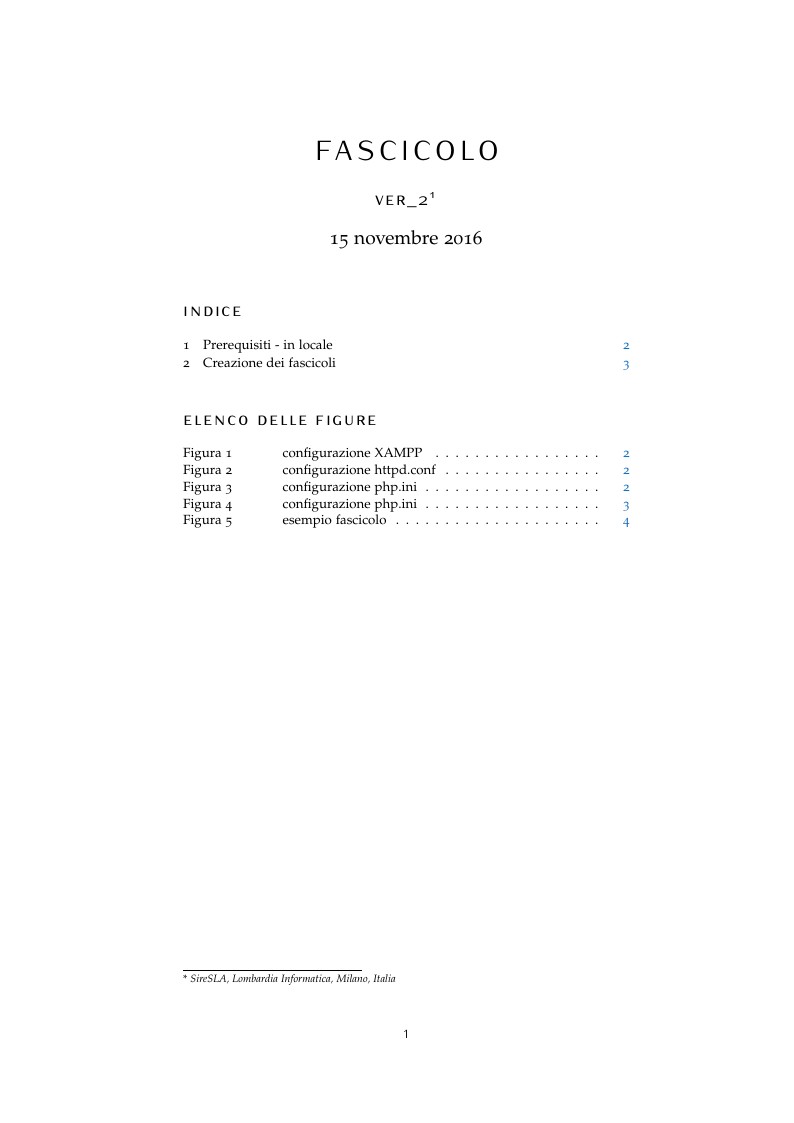
Fascicolo
Author:
Adriano Palombo
Last Updated:
9 yıl önce
License:
Creative Commons CC BY 4.0
Abstract:
Installation instructions for XAMPP

\begin
Discover why over 20 million people worldwide trust Overleaf with their work.
Installation instructions for XAMPP

\begin
Discover why over 20 million people worldwide trust Overleaf with their work.
%%%%%%%%%%%%%%%%%%%%%%%%%%%%%%%%%%%%%%%%%
% Arsclassica Article
% LaTeX Template
% Version 1.1 (05/01/2015)
%
% This template has been downloaded from:
% http://www.LaTeXTemplates.com
%
% Original author: Adriano Palombo
%
%
%%%%%%%%%%%%%%%%%%%%%%%%%%%%%%%%%%%%%%%%%
%----------------------------------------------------------------------------------------
% PACKAGES AND OTHER DOCUMENT CONFIGURATIONS
%----------------------------------------------------------------------------------------
\documentclass[
10pt, % Main document font size
a4paper, % Paper type, use 'letterpaper' for US Letter paper
oneside, % One page layout (no page indentation)
%twoside, % Two page layout (page indentation for binding and different headers)
headinclude,footinclude, % Extra spacing for the header and footer
BCOR5mm, % Binding correction
]{scrartcl}
\input{structure.tex} % Include the structure.tex file which specified the document structure and layout
\hyphenation{Fortran hy-phen-ation} % Specify custom hyphenation points in words with dashes where you would like hyphenation to occur, or alternatively, don't put any dashes in a word to stop hyphenation altogether
%----------------------------------------------------------------------------------------
% TITLE AND AUTHOR(S)
%----------------------------------------------------------------------------------------
\title{\normalfont\spacedallcaps{Fascicolo}} % The article title
\author{\spacedlowsmallcaps{ver\_2\textsuperscript{1}}} % The article author(s) - author affiliations need to be specified in the AUTHOR AFFILIATIONS block
%\date{} % An optional date to appear under the author(s)
%----------------------------------------------------------------------------------------
\begin{document}
%----------------------------------------------------------------------------------------
% HEADERS
%----------------------------------------------------------------------------------------
\renewcommand{\sectionmark}[1]{\markright{\spacedlowsmallcaps{#1}}} % The header for all pages (oneside) or for even pages (twoside)
%\renewcommand{\subsectionmark}[1]{\markright{\thesubsection~#1}} % Uncomment when using the twoside option - this modifies the header on odd pages
\lehead{\mbox{\llap{\small\thepage\kern1em\color{halfgray} \vline}\color{halfgray}\hspace{0.5em}\rightmark\hfil}} % The header style
\pagestyle{scrheadings} % Enable the headers specified in this block
%----------------------------------------------------------------------------------------
% TABLE OF CONTENTS & LISTS OF FIGURES AND TABLES
%----------------------------------------------------------------------------------------
\maketitle % Print the title/author/date block
\setcounter{tocdepth}{2} % Set the depth of the table of contents to show sections and subsections only
\tableofcontents % Print the table of contents
\listoffigures % Print the list of figures
%\listoftables % Print the list of tables
%----------------------------------------------------------------------------------------
% AUTHOR AFFILIATIONS
%----------------------------------------------------------------------------------------
{\let\thefootnote\relax\footnotetext{* \textit{SireSLA, Lombardia Informatica, Milano, Italia}}}
%{\let\thefootnote\relax\footnotetext{\textsuperscript{1} \textit{Department of Chemistry, University of Examples, London, United Kingdom}}}
%----------------------------------------------------------------------------------------
\newpage % Start the article content on the second page, remove this if you have a longer abstract that goes onto the second page
%----------------------------------------------------------------------------------------
% INTRODUCTION
%----------------------------------------------------------------------------------------
\section{Prerequisiti - in locale}
\begin{enumerate}
\item Scaricare XAMPP da \url{https://www.apachefriends.org/it/index.html} e seguire la procedura standard di installazione di un qualsiasi programma per windows.
\item Lanciare l’eseguibile di XAMPP “xampp-control.exe” che si trova in C:$\setminus$xampp
\begin{figure}[h]
\centering\includegraphics[scale=0.5]{xampp}
\caption{configurazione XAMPP}
\end{figure}
\item Qualora non fosse aperta la porta 80 cliccare su Config (di Apache) e aprire il file di “testo” httpd.conf e configurare la porta 80 come segue:
\begin{figure}[h]
\centering\includegraphics[scale=0.5]{httpd_conf80}
\caption{configurazione httpd.conf}
\end{figure}
\item aprire il file di “testo” php.ini e configurare e de commentare la riga 1008 come segue:
\begin{figure}[h]
\centering\includegraphics[scale=0.5]{1008}
\caption{configurazione php.ini}
\end{figure}
\item aprire il file di “testo” php.ini e settare il timeout di risposta a 60 sec come segue:
\begin{figure}[h]
\centering\includegraphics[scale=0.5]{60sec}
\caption{configurazione php.ini}
\end{figure}
\item (chiudere XAMPP e riavviarlo)
\item Copiare la cartella ”Fascicolo” che al momento è sotto la cartella condivisa:\\
C:$\setminus$..$\setminus$A605 - Monitoraggio SLA e Esercizio all'interno di C:$\setminus$xampp$\setminus$htdocs
\end{enumerate}
\section{Creazione dei fascicoli}
\begin{enumerate}
\item Lanciare XAMPP (doppio click su XAMPP “xampp-control.exe” che si trova in C:$\setminus$xampp)
\item Aprire il browser e digitare il seguente path:
\begin{itemize}
\item \url{http://localhost/fascicolo/allSCH_FAS.php} (è un’operazione che richiede circa 3 min)
\begin{itemize}
\item Se l’operazione è andata a buon fine visualizzerete la scritta FINITO
\begin{itemize}
\item Altrimenti fare un refresh della pagina
\end{itemize}
\end{itemize}
In questo modo sarà creata la prima pagina del fascicolo per tutti gli “SCH” e copiate nella cartella: C:$\setminus$xampp$\setminus$htdocs$\setminus$Fascicolo$\setminus$allFAS
\end{itemize}
\item Aprire il browser e digitare il seguente path:
\begin{itemize}
\item \url{http://localhost/fascicolo/allINC_FAS.php}
\begin{itemize}
\item Se l’operazione è andata a buon fine visualizzerete la scritta FINITO
\end{itemize}
In questo modo sarà creata la prima pagina del fascicolo per tutti gli “INC” e copiate nella cartella: C:$\setminus$xampp$\setminus$htdocs$\setminus$Fascicolo$\setminus$allFAS
\end{itemize}
\item Aprire il browser e digitare il seguente path:
\begin{itemize}
\item \url{http://localhost/fascicolo/PDFMerger/mergeAllFascicoli.php} (è un’operazione che richiede circa 5 min)
\begin{itemize}
\item Se l’operazione è andata a buon fine visualizzerete la scritta FINITO
\begin{itemize}
\item Altrimenti fare un refresh della pagina
\end{itemize}
\end{itemize}
In questo modo sarà associata la prima pagina “SCH” o “INC” precedentemente realizzata con gli altri due file pdf di interesse, in modo da avere il fascicolo completo.
I fascicoli realizzati saranno copiati nella cartella: C:$\setminus$xampp$\setminus$htdocs$\setminus$Fascicolo$\setminus$FASCICOLI divisi per FSM$\Rightarrow$SM$\Rightarrow$Fascicolo-SCH-XXX\_XX.pdf
\end{itemize}
\item In ultimo Copiare la cartella C:$\setminus$xampp$\setminus$htdocs$\setminus$Fascicolo$\setminus$FASCICOLI nella cartella condivisa:
C:$\setminus$..$\setminus$A605 - Monitoraggio SLA e Esercizio all'interno di:\\
$\setminus$$\setminus$mega-srv-prod$\setminus$RepositoryFunzione$\setminus$A605 - Monitoraggio SLA e Eser\\cizio$\setminus$FASCICOLO\_STORICO$\setminus$FASCICOLO\_MESE\_ANNO
\end{enumerate}
\begin{figure}[h]
\centering\includegraphics[scale=0.85]{fascicolo}
\caption{esempio fascicolo}
\end{figure}
%----------------------------------------------------------------------------------------
% BIBLIOGRAPHY
%----------------------------------------------------------------------------------------
%\renewcommand{\refname}{\spacedlowsmallcaps{References}} % For modifying the bibliography heading
%\bibliographystyle{unsrt}
%\bibliography{sample.bib} % The file containing the bibliography
%----------------------------------------------------------------------------------------
\end{document}